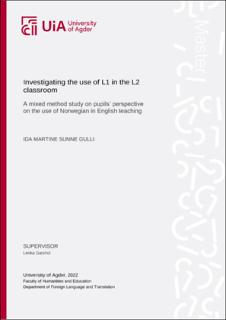| dc.description.abstract | Research into the field of code-switching and language use in the Norwegian English foreign language classroom has been scarce, and with no official recommendations of language use in Norwegian schools, practices vary from school to school, and teacher to teacher. Even rarer are studies into the perspectives and thoughts amongst pupils on the subject. This mixed method study investigates pupils’ perspectives on the use of L1 during L2 teaching in Norwegian lower secondary school. The aim is to uncover pupils’ thoughts on L1 use and their opinions on when Norwegian can be applied naturally or as a necessity into English teaching. Additionally, the research questions sought to disclose factors that may influence the language choices made by pupils during English lessons.
To answer the research questions, a mixed method study comprised of an online questionnaire, completed by 156 pupils attending lower secondary school, and in-depth semistructured interviews with 15 pupils attending the 10th grade were conducted. A total of six schools volunteered for the study, five for the quantitative part (questionnaire) and one for the qualitative part (interviews).
The result of the study suggests that Norwegian is quite commonly used amongst Norwegian pupils during English foreign language lessons, and that they find it both useful and natural for L1 to be applied for certain contexts, i.e., it is natural or necessary for Norwegian to be used when they are provided with information not related to the subject, when the teacher explains an assignment, when working with new vocabulary or grammar, or when collaborating in pairs and groups. However, it seems the main reason behind the extensive use of L1 amongst pupils can be improved as they report the reason to be because it feels unnatural to speak English, or that it is simply easier to answer using Norwegian. Other reasons behind L1 are more easily forgiven, i.e., pupils are uncomfortable with pronunciation, they use Norwegian because the rest of the pupils do, or due to limitations in vocabulary. Moreover, the results imply that the language used by other members of class, as well as the teacher, has a significant impact and influence on the language choices made by the pupils. In other word, Norwegian should be used judiciously and there needs to be some thought behind it. | |
